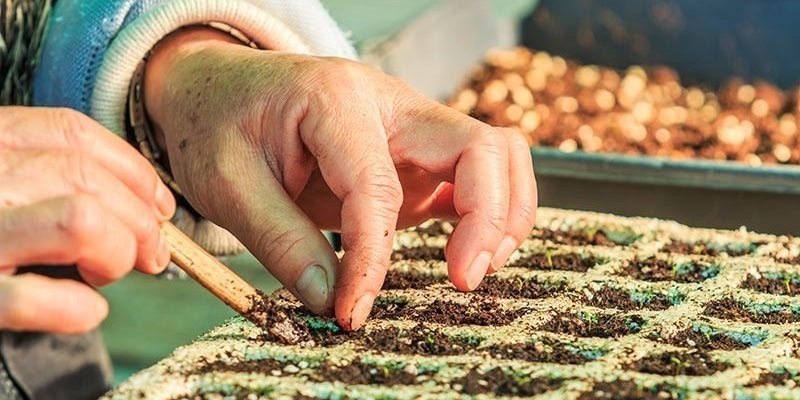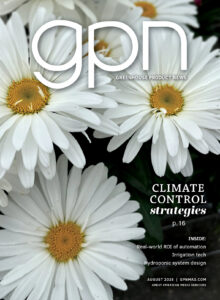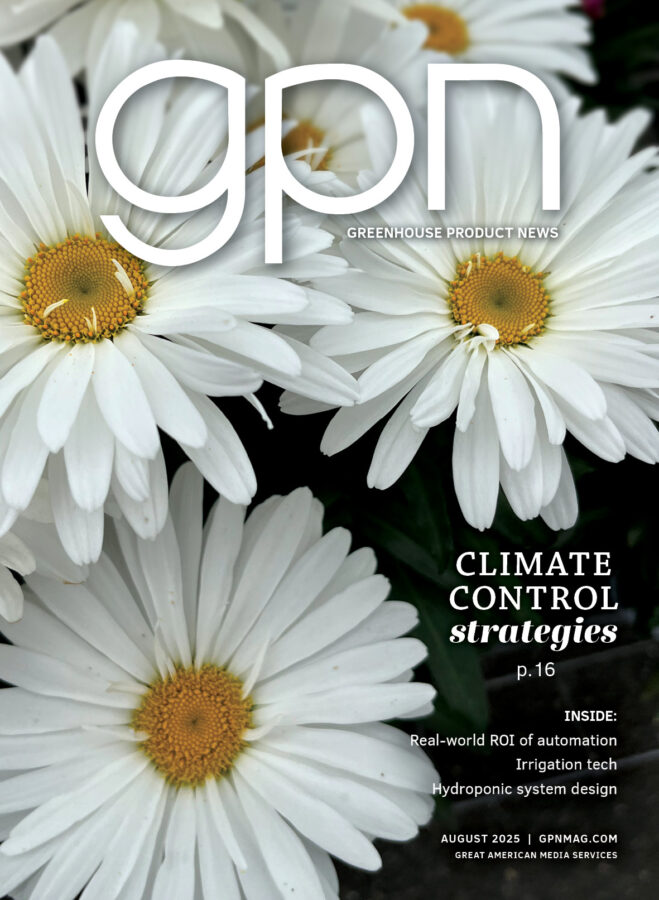
Environmental Horticulture Research at UC Davis
Editor’s Note: This is the fifth article in a series on research and education programs being performed at the University of California.
The Department of Plant Sciences at UC Davis was formed in 2005 by merging four historic departments: Environmental Horticulture, Pomology, Agronomy and Range Science, and Vegetable Crops. The department consists of 70 faculty researchers studying topics from genomics to range management.
There is a long history of publications and texts from these departments that have become educational and industry standards: “Plant Propagation” textbook by Hudson Hartmann and Dale Kester, currently in its eighth edition; “Arboriculture” textbook by Richard Harris, now in its fourth edition; the “Container Nursery Production and Business Management Manual” (Newman 2014) is an extension of the original “The U.C. system for producing healthy container-grown plants: Through the use of clean soil, clean stock, and sanitation, Manual 23” written by Ken Baker in 1957. Greenhouses and nursery operations still use the production principles introduced in this text.
The publications, research, education and outreach offered by the Department of Plant Sciences and the entire University of California system continues to benefit the floriculture, nursery and landscape industries in California and the United States, particularly in the areas of water and drought management, salinity, pathogens, pollutants and lighting technology. Some of the current projects in production and landscape horticulture at UC Davis are described below.
Lieth Lab Group
Heiner Lieth is a professor and Cooperative Extension specialist who studies the ecology of greenhouse and nursery crops, works with greenhouse control and irrigation automation and develops mathematical models of ornamental crops. Lieth’s work focuses on the technological innovations that have led to changes in greenhouse and nursery plant production.
An exciting area in which he and his students are studying is using light-emitting diodes (LED) as light sources for controlled environment production.
While it is well known that LEDs are efficient at producing light, it is not clear how specific light wavelengths affect plant growth. One project examines the effect of red and blue LEDs on flower quality of potted Phalaenopsis orchids. Graduate student Jake Holley exposes plants to various wavelength combinations and light intensities to see if spike length and other plant qualities can be improved and if there is an effect on flower timing.
Other questions regarding LEDs that Lieth’s group examines include : can LEDS be used to control photoperiod, are they effective in indoor hydroponic fruit production, can they be used for greenhouse supplemental lighting, and can LEDs influence stomatal control? Lieth’s lab group is also using a controlled environment production unit they constructed to study high- density plant production.
Oki Lab Group
Dr. Loren Oki’s lab group focuses on water in production horticulture and urban environments. Oki is a Cooperative Extension specialist who works with the landscape and nursery production industry throughout California.
Water is an important resource everywhere and particularly in California with its dry summer climate and current drought conditions. The researchers in Oki’s group are engaged in projects that examine plant salinity tolerance, landscape water conservation, biological water treatment methods and the characterization of runoff water in urban and plant production settings. The work that is conducted will develop information to help growers and landscape managers use water more efficiently and reduce waste when irrigating plants.
Microcalorimetry
Postdoctoral scholar Lloyd Nackley and Ph.D. student Julia Pollex are developing a method using isothermal microcalorimetry to quickly assess plant tolerance to salinity. Current methods can take more than a year, but microcalorimetry may reduce this to only days or weeks, which would be of great benefit to the ornamental plant industry and other crops. There is an increasing use of lower quality water for irrigation. For example, the Irvine Ranch and Santa Clara Valley Water Districts provide reclaimed water to parks, golf courses and commercial landscapes. Reclaimed water is not particularly high in total salinity (electrical conductance is typically between 1.0 and 1.5 dS/m), but salts are mostly in the form of sodium chloride (NaCl). Consequently, landscape plants sensitive to NaCl or total salinity are often stressed, which can result in plant death (Nackley et al. 2015).
When plants are not stressed and growing rapidly, respiration rates and accompanying heat output are greatest. But when plants are stressed, respiration rates and heat production decrease. Microcalorimetry measures these very small amounts of heat production (microwatts) from small pieces of plant tissue (less than 1 cubic centimeter). The researchers are determining which plant part should be used for the assessment: a rapidly growing plant part such as shoot and root tips, intercalary meristematic zones or germinating seeds. Plants are exposed to various levels of salinity, and heat output is measured to assess salinity tolerance. Plants that continue to generate heat when exposed to higher salinity levels are likely to be salt tolerant.
Irrigation Trials
Water requirements of landscape plants are determined in a project led by Karrie Reid, former graduate student with Oki and now San Joaquin County environmental horticulture advisor, and staff research assistant (SRA) Jared Sisneroz (Reid and Oki 2008). This two-year process starts with a November planting to allow plants to become established in the test field during the first year.
During the second summer, irrigation is reduced to 20, 40, 60 and 80 percent of reference evapotranspiration (ET0) as determined by a nearby California Irrigation Management Information System (CIMIS, www.cimis.water.ca.gov) weather station. From the time they are planted, plants are measured for growth and evaluated for quality every month to determine the effects of the irrigation treatments. Near the end of the assessment period, local horticulturists are invited to the field to evaluate plant performance.
All of the data is then used to develop a recommended irrigation level for the plants when used in landscape planting. A compilation of the results are posted online. This information, along with Water Use Classification of Landscape Species (WUCOLS, www.ucanr.edu/sites/WUCOLS), is important to landscape designers and architects when developing landscape plans in compliance with California landscape water conservation regulations that require calculating annual landscape water use.
Biological Runoff Treatment
California regulations prohibit the release of irrigation runoff, so growers capture and reuse the water for irrigation. But this water can contain and disperse plant pathogenic organisms. We are examining the use of slow sand filters (SSFs) to remove pathogens from this captured water.
Our studies show that SSFs are very capable of removing water molds, and recent work, with now-retired UC Riverside plant pathologist Deborah Matthews, has shown that the filters are also capable of removing tobacco mosaic virus (Matthews et al., in prep.) which is the first demonstration of the removal of this virus by SSFs. Former graduate student Mike Harris found that these filters are very effective in removing Phytophthora capsici from runoff water inoculated with that organism. In addition, when filters were exposed and conditioned to remove P. capsici, they were capable of removing a wide range of other introduced Phytophthora species.
Former graduate student Eric Lee found that SSFs exposed to Fusarium oxysporum for seven weeks were not able to remove that organism, but when P. capsici was introduced to those filters, they were immediately removed (Lee and Oki 2013). Also, when the water supply was shut off for seven days, and then restarted, simulating a possible pump failure, there was no loss in the ability to remove P. capsici.
Former graduate student and current SRA Bruno Pitton, along with Dr. Darren Haver, Orange County Cooperative Extension, and SRA Grant Johnson are working on coupling SSFs with vegetated filters to increase flow rates through these treatment systems.
Nursery Hydrology
In a collaborative USDA project led by Sarah White of Clemson University, UC researchers Pitton, Oki and Haver are managing the California aspects of a large nationwide project called “Clean WateR3” (www.cleanwater3.org) to model water movement in nurseries, characterize nutrient and pathogen contents in runoff, and identify key control points and treatment methods to mitigate the contaminants.
To study water movement, we are installing monitoring equipment in nurseries to measure and record water applied as irrigation and the runoff that is generated. Equipment is also used to automatically collect samples so that we can examine them for pathogens and other contaminants. The research team will develop a decision support tool to assist growers in selecting water treatment methods and management practices to reducerunoffandcontaminantcontent.
Residential Runoff Monitoring
Oki’s and Haver’s research groups have been studying runoff from residential neighborhoods for nearly 10 years. Our interest started with the desire to understand the volume of runoff that comes from homes and what was contained in that water. We measured the amount of runoff from these neighborhoods and analyzed water samples for ant control products (fipronil, pyrethroids, and organophosphates; Lin et al., 2009), nutrients, human pathogens and indicators (Reano et al. 2015), and other pollutants. Haver, Pitton, Sisneroz and Johnson continue to work with the California Department of Pesticide Regulation in this monitoring project.
References:
CDFA (2015). California Agricultural Statistics 2013 Crop Year. National Agricultural Statistics Office USDA, Pacific Regional Field Office, California
Lee E, Oki LR (2013). Slow sand filters effectively reduce Phytophthora after a pathogen switch from Fusarium and a simulated pump failure. Water Research 47 (14):5121-5129. doi:10.1016/j.watres.2013.05.054
Nackley LL, Barnes C, Oki LR (2015). Investigating the impacts of recycled water on long-lived conifers. AoB Plants 7. doi:10.1093/aobpla/plv035
Newman J (2014). Container Nursery Production and Business Management Manual vol 3540. University of California Division of Agriculture and Natural Resources, Oakland, California
Reano DC, Haver DL, Oki LR, Yates MV (2015). Long-term characterization of residential runoff and assessing potential surrogates of fecal indicator organisms. Water Research 74:67-76. doi:10.1016/j. watres.2015.01.022
Reid SK, Oki LR (2008). Field trials identify more native plants suited to urban landscaping. California Agriculture 62 (3):97-104. doi:10.3733/ ca.v062n03p97
Serving the California Nursery and Floriculture Industry
California is well known for its agricultural productivity. What is not well known is the value of the environmental horticulture industry in California. In the most recent state agricultural report for the year 2013 (CDFA 2015), nursery as a commodity was ranked 10th at $1.22 billion and floriculture (listed as Flowers and Foliage) by itself is ranked 11th ($1.13 billion). Combining these commodities would rank them fifth following, in order from first place: milk and cream, almonds, grapes, and cattle and calves.
According to a report from the California Association of Nurseries and Garden Centers, the total economic impact on California in 2011 was estimated to be $11.30 billion and employment of 184,202.
Scientists in the University of California are uniquely positioned to provide information developed by research to address the issues that confront the horticulture industry in this state.
The Department of Plant Sciences at UC Davis is in the College of Agriculture and Environmental Sciences (which was ranked in 2013, 2014 and 2015 as the number one university in the world for teaching and research in the area of agriculture and forestry), and researchers in Plant Sciences often work with faculty in related departments and programs such as Viticulture and Enology; Biological and Agricultural Engineering; Entomology and Nematology; Plant Pathology; Environmental Science and Policy; Civil and Environmental Engineering; Human Ecology; Landscape Architecture; and Land, Air and Water Resources.









 Video Library
Video Library 


















